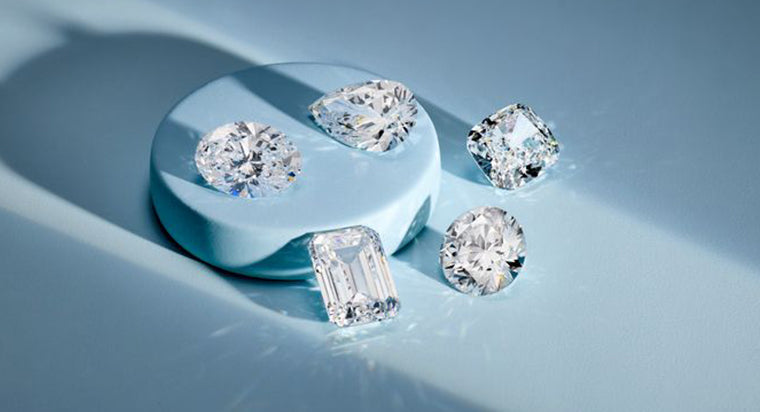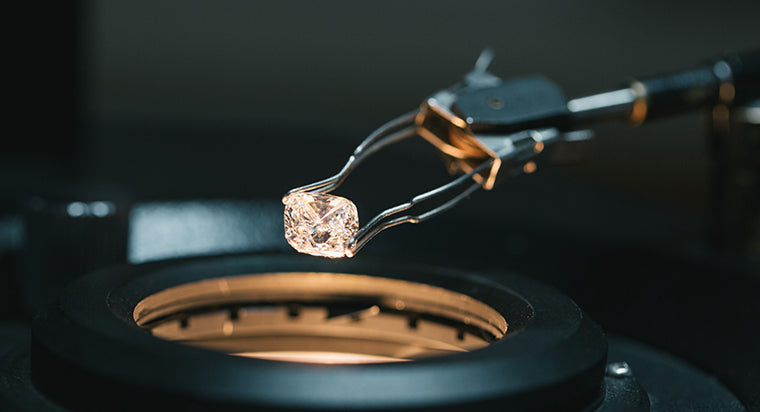Lab Diamond Color Guide

Both natural and laboratory grown diamonds come in many shapes, sizes, and colors. We use the four C's (color, cut, clarity, and carat) to assess the quality of diamonds. Continue reading to explore diamond color, color scale and how to select a lab grown diamond's color.
TABLE OF CONTENTS
What is Diamond Color?
Like natural diamonds, lab grown diamonds vary in terms of quality during their laboratory process. Manufacturers have two ways to create lab diamonds - High Pressure High Temperature (HPHT) and Chemical Deposition (CVD):
- HPHT: A diamond “seed” is added to carbon, which is a small natural diamond fragment that can undergo both extreme temperature and pressure conditions. The HPHT process subjects the seed and carbon to extreme temperatures (in excess of 1,300-1,600 degrees celsius) and pressures (one million pounds per square inch) to replicate the extreme conditions deep within the earth where natural diamonds form
- CVD: The chemical vapor deposition system begins with a diamond “seed.” It’s important to select the strongest and highest grade (in color and clarity) natural diamond bit. During the CVD process, the vacuum chamber in which the diamond seed is placed fills with gases that are heavy in carbon and is then heated to well over 1,000 degrees. The intense heat then turns the gases into “plasma.” The plasma is what helps “build” the layers of the diamonds.
Diamond Color Scale
| Diamond Color Grades | Color Visibility |
|---|---|
| D | Colorless |
| E | Colorless |
| F | Colorless |
| G | Near Colorless |
| H | Near Colorless |
| I | Near Colorless |
| J | Near Colorless |
| K | Faint Yellow |
| L | Faint Yellow |
Colorless (Grades D, E and F)
The highest color grade available. A “D” grade color lab diamond is completely colorless. The diamond will not show signs of any color - even under magnification. Almost as perfect as grade D diamonds, Grade E and F diamonds look colorless to the naked eye.
Near Colorless (Grades G, H, I and J)
To the naked eye these diamonds look relatively colorless (they don't look all that different from Grade E and F diamonds), but they aren't of the same high quality as F, E, and D grades. You will pay much less for a G color lab diamond, and the same applies to an H, I and J graded diamond.
Faint Tint (K, L and M)
Grade K to M diamonds have a faint tint - you'll see a pale-yellow hue if you look closely. These diamonds are pretty and have a warm tone, but aren't considered as high quality.
Very Light Tint (N-R)
These lower grade diamonds have a very light tint. You'll notice a yellow brown hue in these diamonds, and can expect to pay less.
Light Tint (S-Z)
The lowest grade diamonds (S to Z) have a light tint, so a brown or yellow shade will be evident. These diamonds are cheaper to purchase.
Colors Impact on Price
As previously mentioned, the higher the grade, the more you can expect to pay for the diamond. Grade D color is the best you can buy, but E and F are also top-notch. If you opt for G to J grade you can still get a stunning diamond but it will cost you less.
Generally you can expect to pay one third the price on a lab diamond compared to a natural diamond.
Best Color for Diamond Shapes
You might wonder which diamond shapes look better with a higher-quality color grade. Some fancy shapes showcase the color while others hide it. For example, in pointed shapes like pear, marquis and princess show yellow more obviously at the corners. A round brilliant diamond hides color well.
Diamond Color Factors
Carat Weight: If you'd prefer a larger diamond, then don't compromise on the color grade. The two most significant factors when choosing a larger diamond would be cut and color because they affect the look and beauty of a ring more than its clarity and carat.
Fluorescence: If you place your diamond under UV (ultraviolet) light, blacklight, or direct sunlight you might notice a glow coming from it. Fluorescence can have a negative effect on higher colored stones, such as those graded D, E and F. At times, diamonds with very strong blue fluorescence can reveal an oily, milky, hazy or grayish look, dulling, or darkening the diamond.
Buying Tips for Lab Diamond Color
Each diamond is special, so you want to evaluate each lab grown diamond on its own. If what you are searching for is a larger diamond or a bigger carat size, then do not compromise on the color grade. The two most significant factors when choosing a diamond would be cut and color. These two aspects of a ring affect the look and beauty of a ring more than its clarity and carat. That being said, if you plan to purchase a lab diamond above 1 carat, a G or H color grade will minimize the appearance of yellow. If you are unsure about carat weight, the best choice is to pick a lab diamond with a color grade between G through J.
Fancy Diamond Colors
If you like the idea of a diamond with a splash of color you will be pleased to discover that lab grown colored diamonds are affordable and look stunning.
Yellow lab diamonds are available in a number of hues (from pale yellow to vivid) and in different sizes and shapes. The yellow color comes from Nitrogen, which is controlled in a lab environment to determine the shade of yellow. Lab diamonds can also be orange in color (from the solvents used in the growing process) or a shade of blue (from pale to intense) caused by exposure to boron.
Pink is another popular color choice varying from pale pink to a deep shade. Pink diamonds don’t receive their color during the growing process. Instead, the pink is inserted via irradiation and annealing (a process that occurs once the diamonds are formed).

FAQs
Are lab-grown diamonds colorless?
Does the Color of the Diamond affect its sparkle?
Does diamond color affect the price?
Is Diamond Fluorescence Good or Bad?









